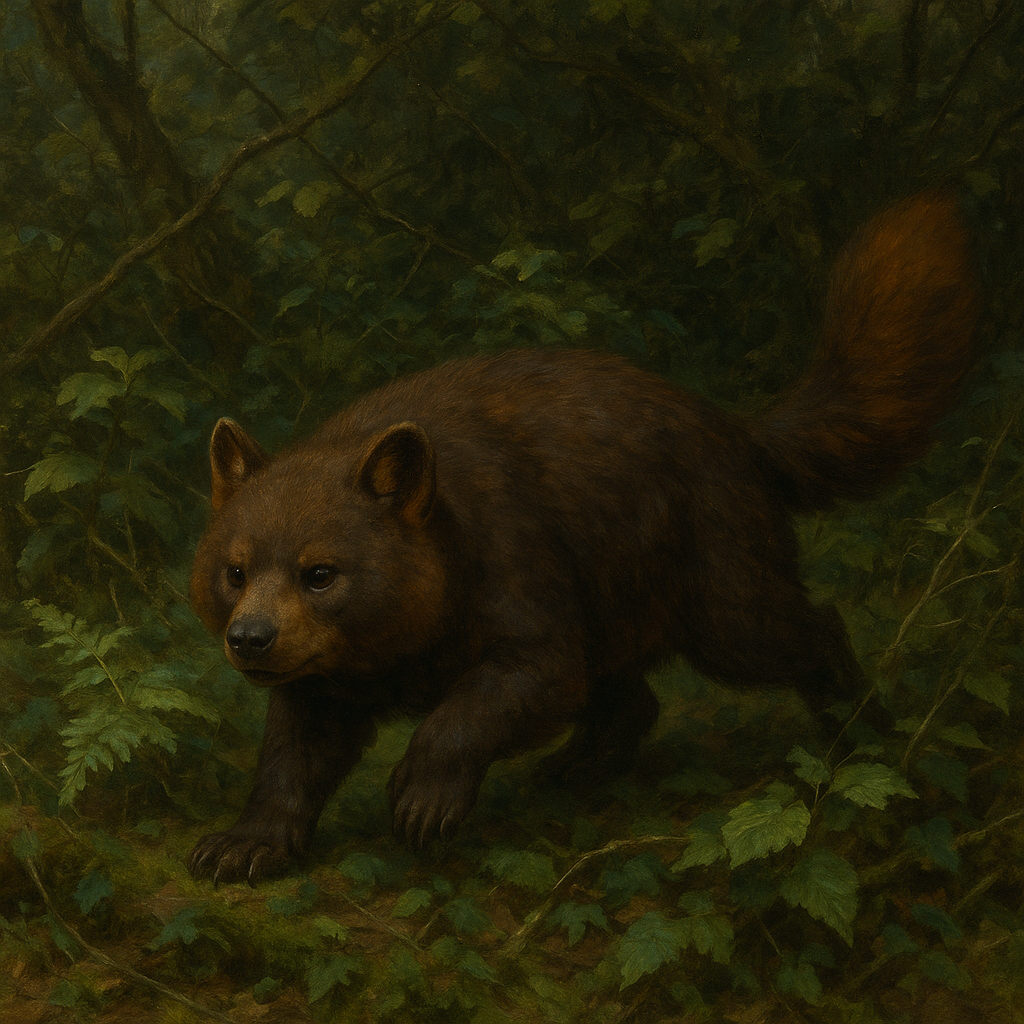Hedgehunters
"It’s not the big things you need fear. Big things make noise. Big things leave marks. No, it’s the quiet ones that watch from the brush… waiting to decide whether they’re scared of you, or hungry."
Compact, cunning, and clad in a coat of earth-toned warmth, the Hedgehunter is a small omnivorous mammal found among the fog-choked woodlands and foothill forests of Everwealth. Somewhere between fox and bear in form, it carries the wary cleverness of the former and the grounded resilience of the latter. Often overlooked due to its size, the Hedgehunter has become a symbol of rural wisdom and survival, stout, quiet, and never quite where you expect it to be. Though often mistaken for a cub or misnamed as a “moss-fox” by travelers, the Hedgehunter is a creature all its own, part forest trickster, part hungry shadow, equal parts curiosity and teeth.Basic Information
Anatomy
The Hedgehunter is stocky and low-slung, measuring roughly two feet long from snout to tail-tip, with a thick, muscular frame that belies its dexterity. Its fur is dense, warm-brown to bark-black, with seasonal variation, often lightening to russet tones in autumn and darkening before frost. Thick, curved claws mark its paws, built more for climbing and burrowing than slashing. The head is distinctly bear-like, but narrower in the muzzle, with forward-facing eyes shaded by a slight brow ridge. Crescent ears, upright and expressive ending in a subtle triangular tip, rise above its rounded skull, often twitching at the slightest sound. The tail, trailing long behind it, provides balance and warmth in equal measure. Some woodfolk compare it to red-furred, ring-tailed creatures allegedly once found here, but now found far to the eastern lands of Kibonoji, seemingly leaving Everwealth in exile with the Elfese; But only in passing, compared to these 'Red Pandas' the Hedgehunter is hardier, sharper, hungrier.
Genetics and Reproduction
Hedgehunters are solitary outside of mating season, with brief pair-bonding in the early spring. They nest in hollows, fallen trunks, or burrows dug beneath stone roots, giving birth to litters of 2-3 kits. These kits mature rapidly, reaching full independence by early frost, though some linger through their first winter for warmth and security.
Growth Rate & Stages
- Kit (0-1 month): Eyes sealed; fur short and paler.
- Youngling (1-4 months): Begins foraging with parent; starts climbing.
- Wanderer (4-10 months): Expands territory; highly curious and reckless.
- Mature (10+ months): Fully grown, solitary unless rearing kits or wintering.
Ecology and Habitats
The Hedgehunter favors dense, mist-wreathed forests, particularly the Boulderrain Woods and Moonpine tracts ringing the Cloudrend Mountains. It thrives in overlapping ecotones of riverbank, deep brush, and cliffside woodland, where it can vanish easily and forage broadly. Its small size makes it vulnerable to larger predators:
- Other native bearkin.
- Deathrattles, the pale lizard-cats who prowl the dark glens.
- Forest-stalkers like who consider it easy sport.
Dietary Needs and Habits
Omnivorous to the point of stubbornness, Hedgehunters feed on fish, eggs, fungi, grubs, berries, and even carrion if fresh enough. They’re fond of trout, particularly those caught in cold-running mountain streams. River fishers often curse them for “stealing gut-pile scraps” left on banks, though others leave out offerings, considering them good luck. Their digestive tracts are robust, evolved to handle spoiled meat or toxic flora, though they will avoid food that another creature has touched, as if suspicious of traps or curses.
Biological Cycle
During the high heat of summer, Hedgehunters are most active, feeding aggressively to build fat for the lean cold. In winter, most enter a half-hibernation: not a true sleep, but a slow, cold-wrapped stillness punctuated by short foraging. They stir only when hunger gnaws hard or warmth returns. Some old woodsfolk say you can tell the shape of spring by the first print of a Hedgehunter in thawed snow. If it points downhill, it will be a wet season. If uphill, a dry one. If you find no tracks at all, stay indoors.
Behaviour
Cautious but bold when cornered, Hedgehunters avoid confrontation unless provoked. If threatened, they hiss sharply and raise their tail high like a banner of warning. They’ve been seen fighting off snakes, rats, and even birds twice their size, flailing and biting in a ferocious, untamed blur. Despite their antisocial reputation, they’re oddly inquisitive. Left alone, one might watch a camp from a tree branch or rummage through bags not for food, but for “interesting textures.” They are known thieves of dyed cloth, particularly red, which they sometimes weave into their dens.
Additional Information
Perception and Sensory Capabilities
While their eyesight is average, Hedgehunters possess extraordinary hearing and a preternatural sense of smell, capable of detecting blood in water from half a mile downwind. Their ears twitch independently, and it is said that they can “hear the silence” when larger predators approach. Some believe their noses can even detect curses on items, and so they are sometimes brought into ruins as living talismans. Whether this is superstition or wisdom remains unproven.
Scientific Name
Vulursus nivalis.
Origin/Ancestry
Believed to descend from smaller bear species that fled high into the mountains after the Fall, the Hedgehunter adapted to dense terrain and subtle tactics to survive.
Conservation Status
Common, but Cautious. Hedgehunters are not endangered, but sightings are rare. They avoid settlements and roads, and their dens are difficult to find. They are not commonly hunted, though their pelts are soft and warm and occasionally used for ceremonial mantles. Forest shamans consider killing one to be ill-omened, a sign that something larger, hungrier, is watching.
Geographic Distribution



Comments